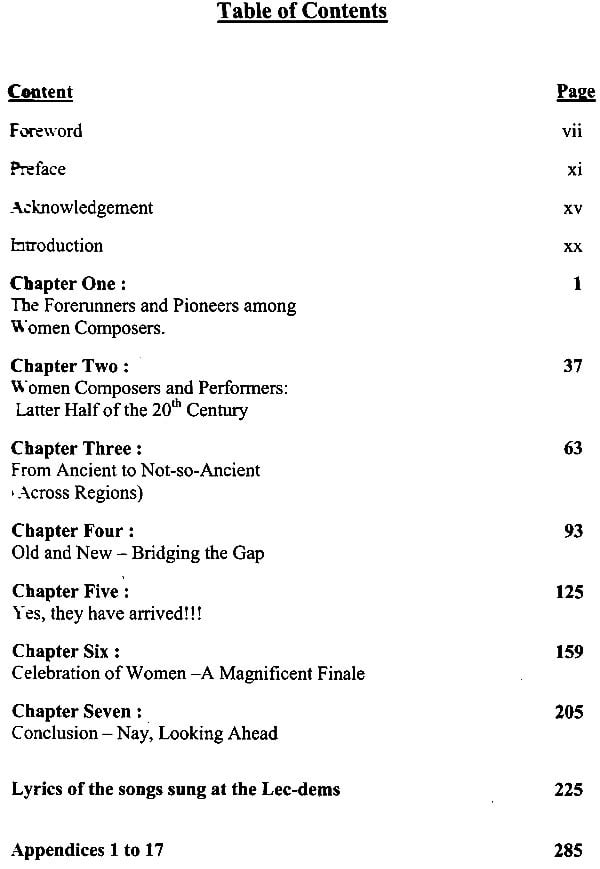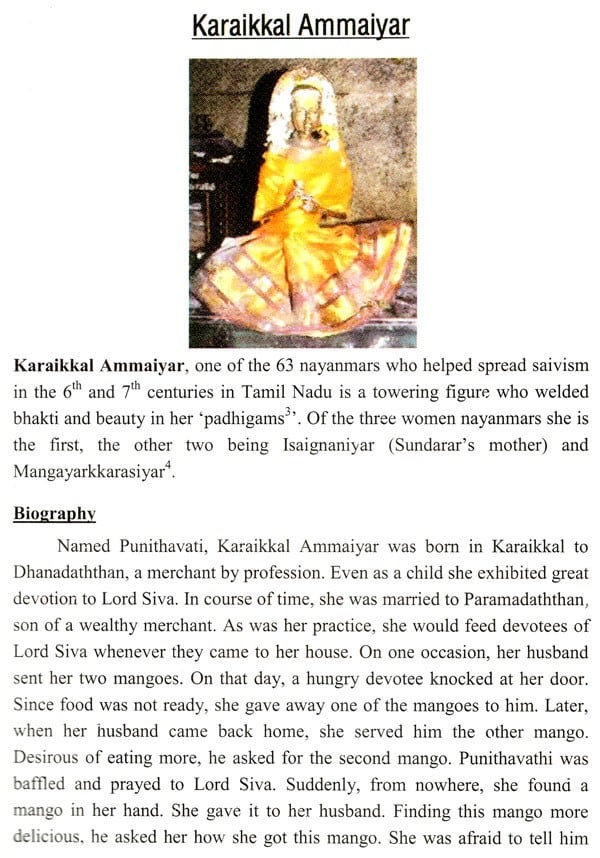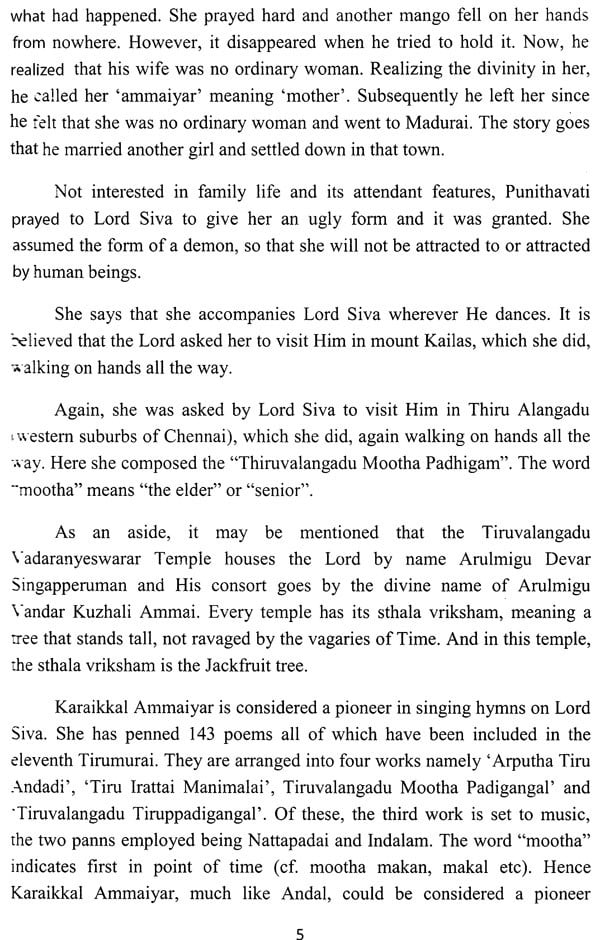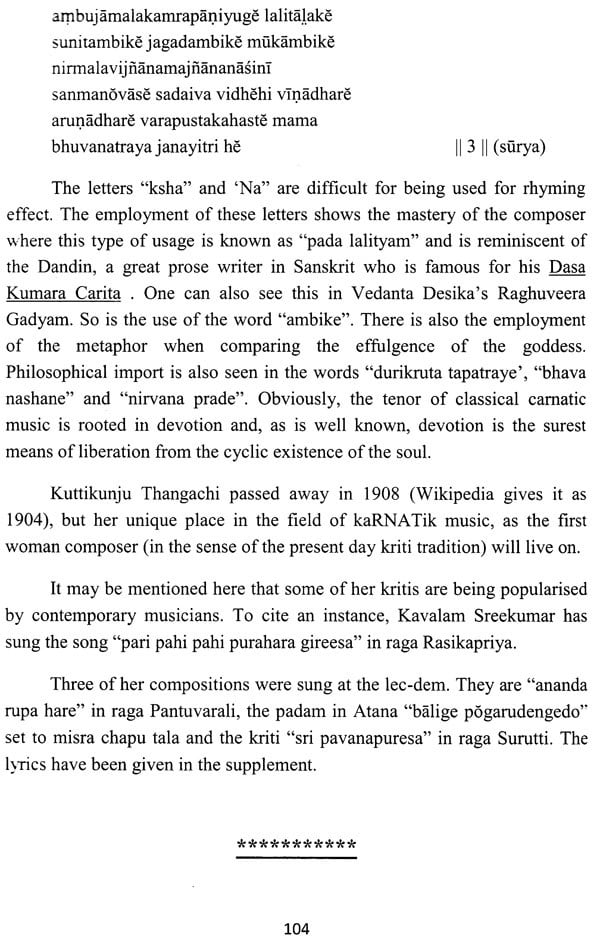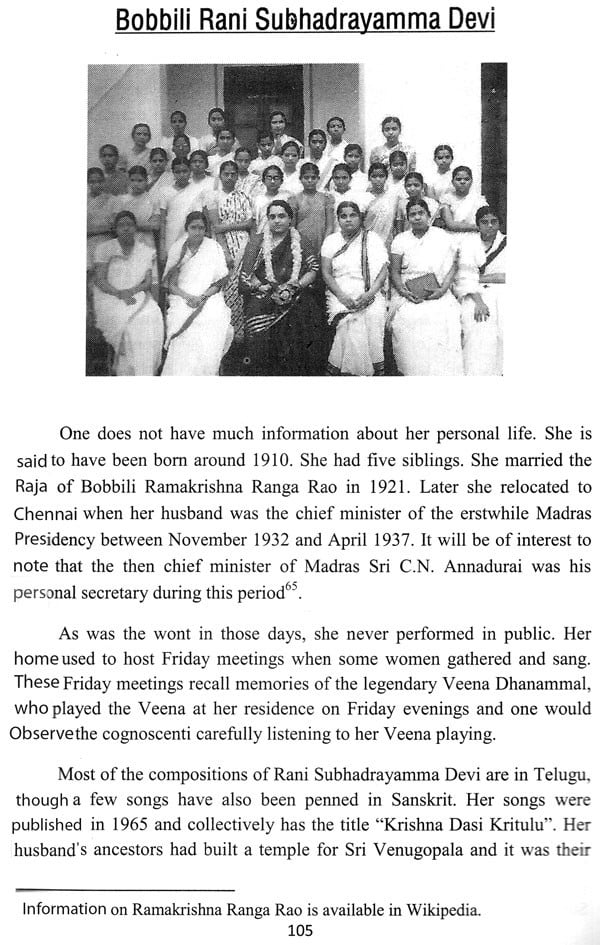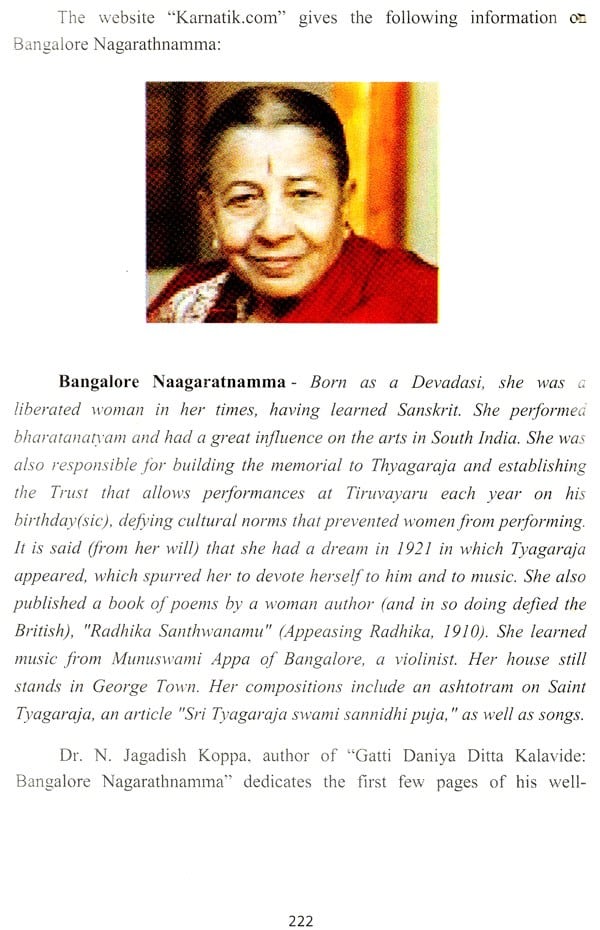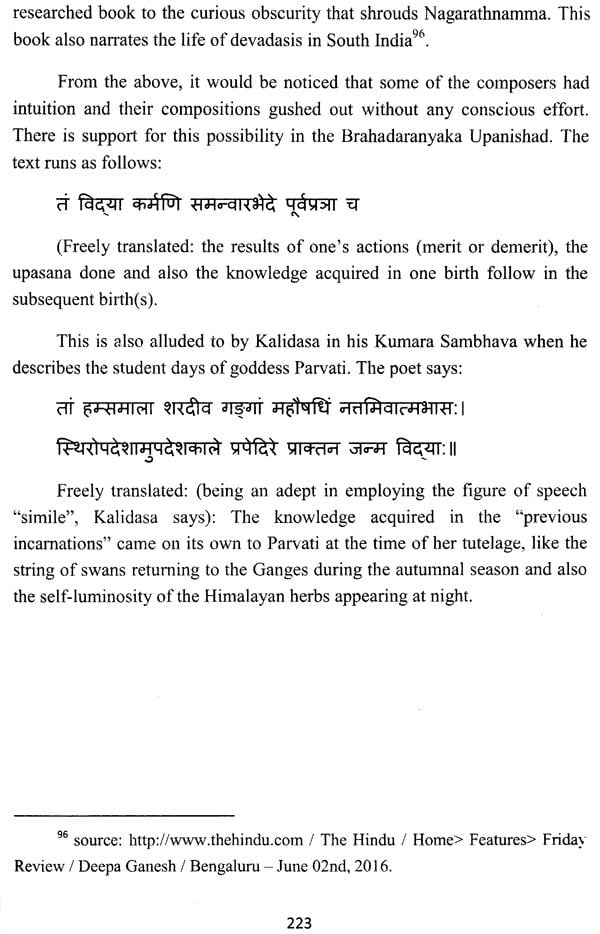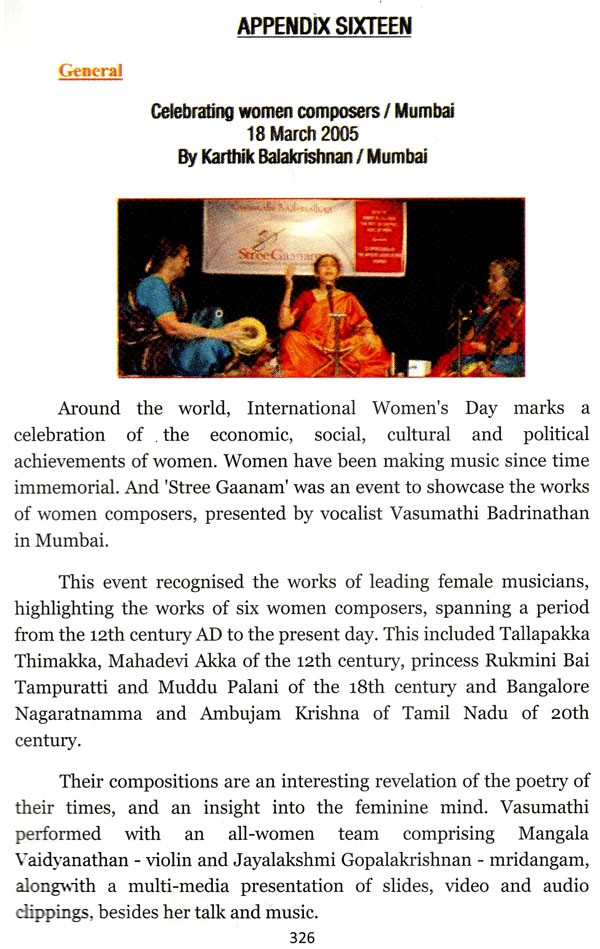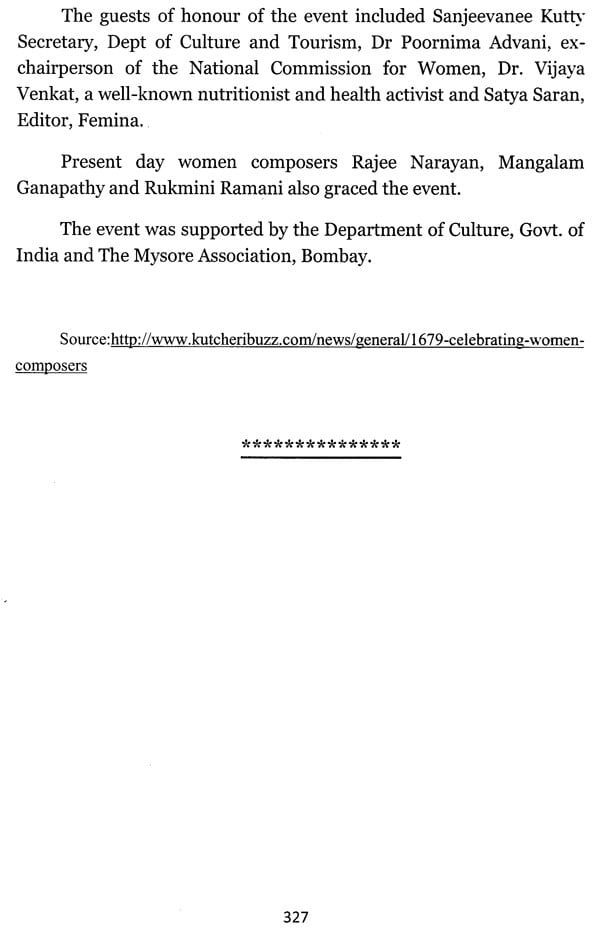
Musical Gems Of Women Maestros
Book Specification
| Item Code: | NCZ036 |
| Author: | Alamelu Ramakrishna |
| Publisher: | Carnatic Classicals, Chennai |
| Language: | Sanskrit and English |
| Edition: | 2020 |
| Pages: | 335 (Throughout Color Illustrations) |
| Cover: | PAPERBACK |
| Other Details | 9.50 X 6.60 inches |
| Weight | 660 gm |
Book Description
Her inter-disciplinary doctoral thesis was on "Comparative study of aesthetic experience in English (romantic) literature and carnatic music", under the guidance of Prof. Dr. N. Ramanathan, head of the Department of Indian Music, University of Madras and Dr.C.T. Indra, head of the Department of English,' University of Madras, as co-guide.
She has done the two year Sangita Vidwan course from the then Central College of Carnatic Music, Chennai, completing it with a distinction in music theory and first class in music practical’s, and followed it up with a "stage performance course". She has had tutelage under various eminent vidwans, apart from pursuing music in the music college, leading to a diploma.
The present publication is a result of her research on the contribution of women composers to Carnatic music. Earlier she was awarded a senior fellowship by the Ministry of culture for working on "Aesthetics in the Music of the Trinity". She is also the recipient of the prestigious Tagore Research Fellowship awarded by the Ministry of Culture, Government of India, under which she has recently brought out a critical edition and translation into English of an ancient unpublished manuscript titled Arjuna Bharatam, working for the Thanjavur Maharajah Serfoji Saraswati Mahal Library, Thanjavur, Tamil Nadu. Along with Dr. S.A. K. Durga, she brought out translation into English of lsai Marabu, a section on music in the ancient Tamil treatise Pancha Marabu, along with supplementary notes and comments. Two other sections of the same book, namely Tala marabu and Vachia marabu have also been translated and are ready for publication.
She has presented papers in national and international conferences on different aspects of music and musicology, given lecture demonstrations on several topics such as Krishna Leela Tarangini, Advaitam in Muthuswami Dikshitar, the nava rasa in the compositions of Tyagaraja, Vallalar and his contribution to music, Meera bai, Devi as an embodiment Of Music etc., and has given concerts at various fora, thematic and otherwise.
A great service has been done by the author, Dr. Alamelu Ramakrishnan, in discharging the debt of the music world to these glorious composers by bringing to light their inspired compositions, hitherto either unknown or little known. This book is at once a grateful acknowledgement of their contributions and an addition to the information available in the field.
Whether it is a credit or discredit, the hallmark of writers and composers in India, in the past, has been their anonymity. For instance, very little is known about Valmiki, Vyasa, Kalidasa and a host of others.
The Ministry of Culture awarded me a performance grant to enable me to present 6 episodes on the contribution of "women composers in Carnatic music" in the year 2015-16.
The credit for choosing this topic must go to my friend, mentor and guide, the late Dr. S.A.K. Durga, a musician and musicologist of international renown. She suggested that I should work on this topic and bring to light many women composers, whose compositions are not often heard on the concert platform, since they were not born to fade unsung.
In the structuring of the program, Smt. Nandini Ramani, a renowned dancer and dance critic helped me a lot and guided me.
I started from the period of Karaikkal Ammaiyar and Andal (saints in the Saivite and Vaishnavite traditions of the 7th and 8th centuries) and tried to present the contributions of women composers in a fairly chronological order (not adhering to it very strictly), right up to the present day. I may mention here that fortunately, a number of very talented and inspired women composers are living in our midst today.
I covered the four southern states of Kerala, Karnataka, Andhra Pradesh and Tamil Nadu and introduced as many composers as I could, in these six presentations.
An interesting but not widely researched area of work is the contribution of women to such compositions in carnatic music. To bring to light the unknown and not-so-well-known composers, I had taken up this project, under the aegis of the Ministry of Culture, government of India. As is well-known in the fine arts circles, Ministry of culture encourages efforts of creative and innovative nature by researchers and performers of fine arts.
Under the inspiration and guidance of renowned scholars in this area like Dr. S.A. K. Durga and Nandini Ramani, I sought performance grant from the Ministry for six lec-dems covering as many of the women composers as I could, starting from Karaikkal Ammaiyar to contemporary times. It is of interest to note that Cilappadikaram talks about Tamil music that existed in 100-200 AD. One of the main female characters is a composer/performer. Setting to work on my chosen theme, I identified and found information on women composers from the southern states of Kerala, Karnataka, Andhra Pradesh (including Telangana) and Tamil Nadu. A variety of compositions like kritis, kirtanas, tillanas and varnams and set various ragas and different talas have been presented at the lecture demonstrations.
Book's Contents and Sample Pages
